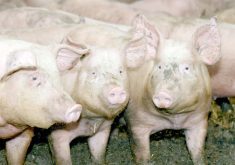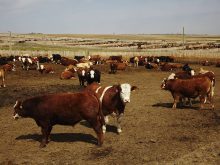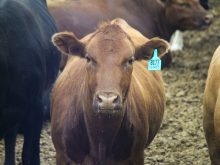Confusion in the Canadian cattle industry is unlikely to be resolved for at least the next 18 months, says the latest market analysis by livestock broker Rick Wright.
Record-high corn and barley prices and oil at nearly $150 per barrel has raised the cost of gain to $1.05 per pound on a 750 lb. steer, Wright said.
However, with 70 percent of production heading to the United States, the biggest unknown factor facing producers is that country’s looming country-of-origin labelling (COOL) legislation.
With widely varying opinion in the United States on the ultimate impact of COOL, Canadian producers are hoping their cattle fall into the category of “may contain,” Wright said.
Read Also

Lending policy still focused on primary producers: Farm Credit Canada
Farm Credit Canada said it has not changed its business practices and remains committed to supporting all producers, after a report from an Ottawa-based media outlet claimed otherwise.
That would allow packers to combine exported meat with U.S. product.
“We don’t even know today what size or kind of label or where it’s going to have to be put, or whether it’s going to specify if it’s Canadian or American, or whether the major packers are going to segregate the cattle.”
The strong Canadian market over the past 30 days has reduced the flow of cattle to U.S. slaughterhouses, which has almost halted separate killing days for Canadian beef.
Wright said the prospect of a 100-day rule looks positive on the surface. It would make Canadian cattle fed in the U.S. for 100 days U.S. citizens and no longer required to be segregated.
“If you look at the entire program, however, it would absolutely cripple our slaughter business up here. We would lose all our packing plants because nobody would want to kill Canadian cattle,” he said.
“Then if the border closes, what would we do with our Canadian cattle?”
Faced with sharply lower prices, Wright said half of Canada’s producers would hang onto their calves longer in the fall, while the other half might choose to sell, hoping that selling their extra hay and barley might compensate for their losses.
Alberta’s new age verification rules mean feedlots in that province need to have age-verified calves or they won’t be eligible for government assistance of 12 to 18 cents per pound.
“If you don’t age verify your calves, you are going to eliminate Alberta as a buyer, almost guaranteed,” he said, adding feedlots in that province may strongly influence markets if the spread between corn and barley stays near $3.
“In most cases, there will be three to five cent premium on age verified calves. It may not be a premium; it might be a discount on those that aren’t.”














